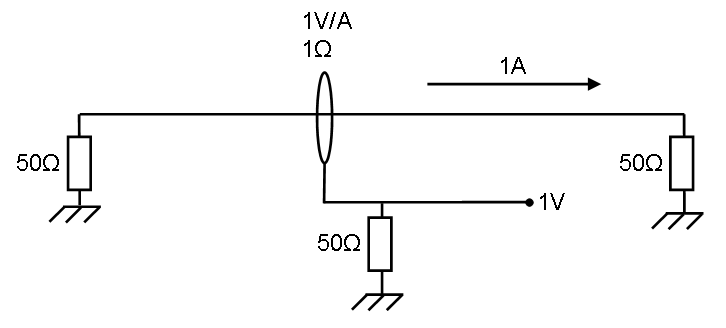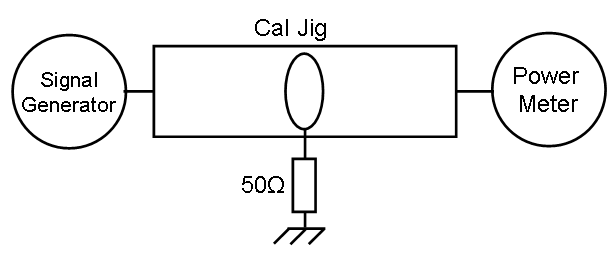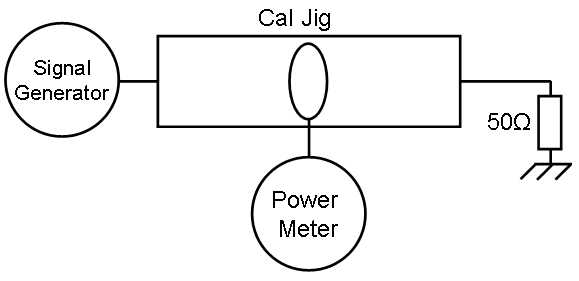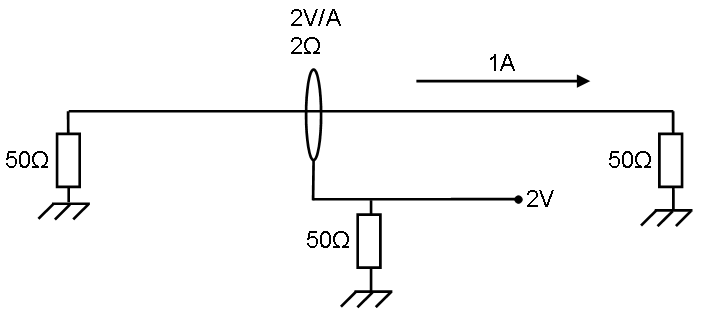Difference between revisions of "Current sensor transfer impedance determination method"
m (Current sensor impedance determination method moved to Current sensor transfer impedance determination method: wrong name) |
|||
| (14 intermediate revisions by one other user not shown) | |||
| Line 1: | Line 1: | ||
| + | = Theory = | ||
[[Image:Current sensor Transfer impedance Prove.PNG]] | [[Image:Current sensor Transfer impedance Prove.PNG]] | ||
| − | {{note|This method is not a replacement for a real calibration | + | The left impedance is the signal generator which is generating enough power for 1 ampere. |
| + | |||
| + | This 1Amp. generates <math>P = I^2*R=50 \ Watt</math> in the right impedance. | ||
| + | |||
| + | The current sensor has 1 ohm transfer impedance, this means 1 ampere generates 1 Volt on the measuring part below. | ||
| + | |||
| + | The power in the lower 50 ohm impedance is <math>P = \frac{U^2}{R} = 20 \ mWatt</math> | ||
| + | |||
| + | So 1 ohm: <math>10*^{10}log(\frac{0,02}{50}) \approx -33,98 dB = -20*^{10}log(50)</math> | ||
| + | |||
| + | = Reference measurement = | ||
| + | [[Image:Current sensor Transfer impedance Ref measurement.PNG]] | ||
| + | |||
| + | = Probe measurement = | ||
| + | [[Image:Current sensor Transfer impedance final measurement.PNG]] | ||
| + | |||
| + | = Calculation = | ||
| + | <Math>Correction \ factor (dB)= P_{Measured} - P_{Reference}+ 33.98</Math> | ||
| + | |||
| + | <Math>P_{Measured}</Math> and <Math>P_{Reference}</Math> in dBm. | ||
| + | |||
| + | |||
| + | = Example = | ||
| + | On 10 MHz we have the following information: | ||
| + | *Calibration: 0 dBm. | ||
| + | *Measurement: -27,96 dBm. | ||
| + | |||
| + | So: | ||
| + | <math>Imp.=-27,96-0.00+33.98=6,02 dBOhm</math> | ||
| + | |||
| + | <math>Imp.\approx 2 \ Ohm</math> | ||
| + | |||
| + | == Verification == | ||
| + | |||
| + | [[Image:Current sensor Transfer impedance example.png]] | ||
| + | |||
| + | The left impedance is the signal generator which is generating enough power for 1 ampere. | ||
| + | |||
| + | This 1 Ampere generates <math>P = I^2*R=50 \ Watt</math> in the right impedance. | ||
| + | |||
| + | The current sensor has 2 ohm transfer impedance, this means 1 ampere generates 2 Volt on the measuring part below. | ||
| + | |||
| + | The power in the lower 50 ohm impedance is <math>P = \frac{U^2}{R} = 80 \ mWatt</math> | ||
| + | |||
| + | So 2 ohm: <math>10*^{10}log(\frac{0,08}{50}) \approx -27,96 dB</math> | ||
| + | |||
| + | The difference to a 1 Ohm impedance is <math>-27,96 - (-33,98) = 6,02 dB</math> | ||
| + | |||
| + | ==Conclusion== | ||
| + | |||
| + | Correction to a 1 ohm impedance is <math>20*^{10}log(R_{probe})</math> | ||
| + | |||
| + | |||
| + | {{note|This method is not a replacement for a real calibration as it may be performed by a none traceable device}} | ||
| + | |||
| + | [[Category:RadiMation]] | ||
Latest revision as of 07:47, 31 July 2014
Contents
Theory
The left impedance is the signal generator which is generating enough power for 1 ampere.
This 1Amp. generates in the right impedance.
The current sensor has 1 ohm transfer impedance, this means 1 ampere generates 1 Volt on the measuring part below.
The power in the lower 50 ohm impedance is
So 1 ohm:
Reference measurement
Probe measurement
Calculation
and in dBm.
Example
On 10 MHz we have the following information:
- Calibration: 0 dBm.
- Measurement: -27,96 dBm.
So:
Verification
The left impedance is the signal generator which is generating enough power for 1 ampere.
This 1 Ampere generates in the right impedance.
The current sensor has 2 ohm transfer impedance, this means 1 ampere generates 2 Volt on the measuring part below.
The power in the lower 50 ohm impedance is
So 2 ohm:
The difference to a 1 Ohm impedance is
Conclusion
Correction to a 1 ohm impedance is















